Improving your Shopify site’s SEO can help increase visibility on search engines and improve the user experience. One of the ways to boost your rankings is by using a Shopify SEO app. But with dozens of apps on the Shopify market that claim to be the best, which ones are truly worth your time?
To help you find the right plugin, I compiled a list of tools and meticulously reviewed all of their features. I cut down the list and hand-picked the 11 best SEO apps for Shopify that can help you automate tasks and improve rankings.
11 best SEO apps for Shopify: in-depth reviews
I researched and tested more than two dozen best Shopify apps for SEO optimization in terms of their ease of use, features, pricing, and other factors. Here are all of my carefully chosen apps reviewed in detail:
1. TinyIMG – best overall Shopify SEO app

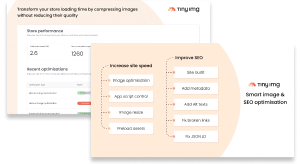
After testing dozens of apps, I chose TinyIMG as the best Shopify SEO app. It comes with a generous free plan and offers a comprehensive feature array for improving your store’s search engine rankings.
Why I picked it:
TinyIMG is my top choice because of the convenient features it offers. For example, I particularly liked the bulk metadata and alt text editing, which helps save a lot of time. There are also site audits that you can run to figure out any SEO issues your pages contain.
This app makes it particularly easy to automate some SEO tasks without coding. For example, you can set up JSON-LD by adding details about your store or hide selected pages from sitemaps and search engines with one click.
TinyIMG is also an image optimization app. During my tests, it compressed PNG files by 94% and JPG files by 54%. Together with the one-click lazy loading or asset preloading features, it can help ensure faster loading times, which is important for getting higher ranks.
Who it’s for:
I recommend TinyIMG to both beginners and intermediate Shopify store owners who lack comprehensive SEO features from Shopify. It helps automate tedious SEO tasks like metadata editing or image compression and speed up your website.
Pros
- Automated SEO features
- Audits for pinpointing SEO issues
- High-quality image compression
- Helps fix broken links
- 24/7 customer support live chat
Cons
- The free app version doesn’t fix broken links
2. Booster SEO – autopilot Shopify SEO app


Booster SEO is one of the top Shopify SEO apps because it's a great way to stay visible on Google result pages with less manual work. With the help of AI, this application continuously monitors your site for SEO issues.
Why I picked it:
Setting up the Booster SEO app was very simple – it took just a few steps. Unlike SEO King and a few other apps, I found the dashboard completely intuitive, so it’s a great choice for beginners.
I really liked the AutoPilot section where all SEO automation features are placed. It offers one-click image alt text, target keyword, meta title and meta description, broken link, and image optimization. Plus, you can use Booster SEO to run SEO audits and locate any potential issues or optimize your URLs with relevant keywords.
The drawback for me was the highly limited free plan. But you can test out the premium tiers with a 7-day trial.
Who it’s for:
Booster SEO is a great choice for small Shopify businesses looking for a premium app to unlock all SEO optimization features. It can help you to not just improve your rankings but boost your store’s speed as well.
Pros
- Optimizes URL keywords
- Automated image optimization
- Automatic JSON-LD
- Weekly image sync for free
Cons
- Some users report uninstallation issues
3. Avada – SEO app for advanced Shopify merchants

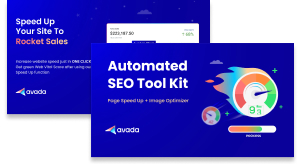
I found that Avada is another great SEO app for Shopify stores that want to optimize their work process. While it’s on the pricier side, it comes with a variety of features, from image optimization to meta tag management, and more.
Why I picked it:
I liked Avada’s SEO audit feature, which shows you all the issues on specific pages. You can then edit them and change the main keyword, preview meta tags, generate metadata with AI, or change the URL handle.
You can also easily verify your site on Search Console, Pinterest, and other platforms. Plus, the app comes with broken link fixing, JSON-LD setup, and image compression. My tests showed a 68% compression rate for PNG and 9% for JPG images.
The only drawback I noticed was the price – their paid plans start from $34.95/month. That’s way more per month than TinyIMG, which has similar functionalities available and better image compression rates.
Who it’s for:
I recommend Avada for large stores that are looking for premium tools to optimize their SEO faster. It helps improve your workload with automation and offers a convenient interface.
Pros
- Unlimited image compression (paid plan)
- Extensive selection of SEO features
- Uncomplicated app usability
- 24/7 customer support
Cons
- Expensive subscriptions
- Some clients claim much lower speed scores
4. Smart SEO – SEO app for building backlinks

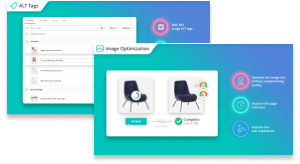
Smart SEO is a reliable Shopify app for improving your website’s SEO with a powerful backlink strategy, automatically fixing broken links, or enhancing content with keywords using AI.
Why I picked it:
Smart SEO caught my eye with its minimalistic yet very user-friendly interface. You can easily bulk edit alt tags or use the integrated ChatGPT-4 Turbo to generate metadata with AI, ensuring your pages look great for search engines. The JSON-LD feature makes it convenient to add structured data without any coding needed.
There’s also an image optimizer, which can help ensure better page speed. During my tests, it compressed PNG files by 69% and JPG by 51%. That’s a decent result, but if you’d like higher compression rates, I suggest looking at TinyIMG or SEOAnt. What I liked most was the detailed backlink report, which gives you useful insights and can help improve site authority.
Who it’s for:
If you’re a store owner looking for a beginner-friendly app that automates meta tag generation, image optimization, and other SEO features, I’d recommend trying Smart SEO. It’s great for fixing any broken links or analyzing your backlink strategy, too.
Pros
- Backlink analysis
- Broken link fixing
- Image compression
- Great customer support
Cons
- Complicated subscription plan structure
- Premium plans are limited
5. Tapita – Shopify app for better SEO and loading speed


Tapita is a feature-loaded Shopify SEO app that comes with a generous free plan and can help optimize your store for search engines and speed. It offers a keyword generator, speed booster, and many functionalities to make your site look good on search engines.
Why I picked it:
I liked the feature variety that Tapita offers. You can configure structured data, fix broken links, conduct keyword research, automate alt text optimization with templates, and more.
The SEO tools include premium features that you can order, such as content audit or writing and getting backlinks. I also connected my Google Search Console account to see the search performance report and I could also manage sitemaps and page indexing, making it convenient to track my results.
There’s an SEO audit tool that gives you insights about your pages, but I lacked quick-fix options. Plus, the keyword research tool offers just 10 keywords per result with the Basic plan.
Who it’s for:
I suggest Tapita for intermediate users who need quick SEO insights and content optimization services. It helps ensure no important on-page SEO elements get overlooked, helping ensure higher rankings.
Pros
- Generous free plan
- One-click speed optimization
- On-page and general SEO audits
- Keyword generator
Cons
- Complicated pricing
- Limited keyword research allowance
6. SearchPie – top beginner-friendly Shopify SEO app

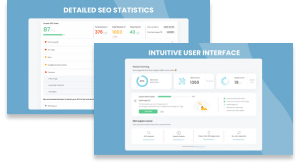
I put SearchPie on this Shopify SEO app list because of how well it caters to beginner users. There are no complicated technical SEO terms, everything is explained, and the interface is intuitive.
Why I picked it:
SearchPie offers features for image compression and speed optimization, such as PNG compression, lazy loading, and AMP pages. I even got to edit alt texts in bulk, which is useful to save time.
For external SEO, there’s the backlink analysis feature that allows you to optimize your strategy and show Google that your content is credible. You can also leverage other SEO features, like meta tags, SEO audits, or broken link fixing.
However, the Premium plan costs $39/month, which customer reviews have deemed a bit pricey. Still, the free version offers more features than some other apps, like Booster SEO.
Who it’s for:
While Searchpie is great for beginner users, I’d recommend it to anyone who wants a simple yet comprehensive solution for SEO optimization. If the price point doesn’t look too steep, this app has plenty of features to improve your rankings.
Pros
- Mobile website performance optimization
- Backlink analysis
- Image compression
- AI product description generator
Cons
- Limited to 10 pages
- Expensive premium plans
7. SEOAnt – simple app for improving your SEO score

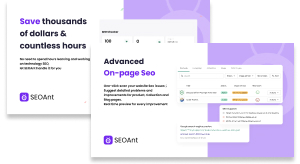
SEOAnt is another great SEO app for Shopify stores that are looking to improve their store’s appearance in search engines.
Why I picked it:
I discovered that this app comes with some unique features, like local business, instant index, and Google Analytics. They help manage your appearance in search engines and conveniently check analytics.
SEOAnt’s SEO checker gives you a site score, letting you know how many page elements you need to improve. For example, it allowed me to instantly improve alt texts, meta titles, and meta descriptions with AI or turn on AMP.
During my image compression tests, the app reduced PNG images by 97% and JPG images by 48%. That’s a much higher rate compared to apps like Avada, but keep in mind that users also reported some issues with size reduction.
Who it’s for:
I’d recommend SEOAnt for small stores looking to boost their SEO by eliminating minor issues. It performs a comprehensive site check, providing great SEO insights to point your store in the right direction.
Pros
- Built for Shopify
- SEO score
- Great image compression rates
- Search appearance features
Cons
- Users report image compression issues
- Complaints about post-free trial cancellation charges
8. StoreSEO – budget-friendly SEO app


StoreSEO can be a huge help in improving the SEO aspects of each of your pages. While it isn’t focused on automation, it also comes with image optimization and AI features to help improve site speed and optimize content with relevant keywords for SEO.
Why I picked it:
StoreSEO gives an individual SEO score for each of your pages, so I could immediately fix individual pages accordingly. For example, it showed me where the focus keyword is missing, what images don’t include an alt text, and more. You can even use AI to optimize meta tags.
There’s also an image optimizer that you can use to compress images and speed up your store. I liked that I could connect my Google Analytics and Search Console accounts so the most important data is always available.
However, I lacked some automated SEO features that apps like TinyIMG or Booster SEO provide. You can bulk edit alt texts but not metadata. Plus, there’s no option to fix broken links.
Who it’s for:
If you run a small to medium-sized store and want a powerful solution for improving individual pages for SEO, I’d suggest giving StoreSEO a shot.
Pros
- Plans for stores of all sizes
- Has a free plan
- SEO score for individual pages
Cons
- Limited feature variety
- Not many automated features
9. SEO Manager – Shopify app for SEO score monitoring

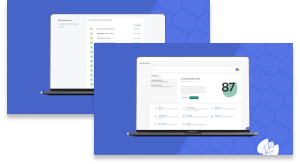
SEO Manager is a good tool for identifying ways to improve website SEO and implementing the suggestions. It’s useful for site auditing and focuses on bulk edits to optimize your SEO work.
Why I picked it:
I liked that the SEO Manager app gives you an overall site SEO score. You can use the tool to scan your pages and fix issues with metadata, canonical URLs, title tags, and more. Plus, the metadata, broken link fixing, and image alt text tasks allow bulk edits, helping you improve SEO while saving time.
You can use search analytics to monitor top pages and queries straight from the dashboard. What I didn’t like was that there was no free plan. Plus, customer support doesn’t answer any 1-star rating reviews on the app store. If you’re in need of more customer-oriented SEO apps than SEO Manager, take a look at TinyIMG or Booster SEO.
Who it’s for:
I’d suggest the SEO Manager app for small to medium-sized businesses who want to track search result data and monitor their SEO score. It helps you leverage bulk edits so you won’t miss any big SEO mistakes on your pages.
Pros
- SEO score
- Bulk edit features
- Search analytics
Cons
- Lack of support efficiency
- No free plan
10. SEO King – AI-driven SEO app for profitable product descriptions

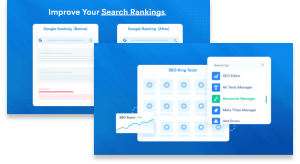
SEO King made my list of Shopify SEO apps because of its versatility. While its interface could be more beginner-friendly, it’s loaded with on-page and technical SEO features as well as AI functionality integration.
Why I picked it:
I enjoyed that SEO King has so many SEO and speed features. You can use SEO audits or SEO checklists to improve your store based on recommendations. I tried generating the metadata and product description with its AI feature, and it implemented all the item-specific keywords that I added.
SEO King has plenty of other tools useful for SEO, including image compression, broken link fixing, redirect creation, robots.txt file management, and more. However, the interface of SEO King is quite overloaded and difficult to navigate, so if you’re looking for a more user-friendly solution with similar features, try out TinyIMG or Booster SEO.
Who it’s for:
I’d suggest SEO King to intermediate users who are looking for a variety of SEO and website optimization features. You can try out the free Shopify app, and if the interface isn’t a deal-breaker, this app will be very helpful for your store’s rankings and user experience.
Pros
- AI content generator
- Unlimited image optimization
- Useful SEO scan
Cons
- Interface could be more user-friendly
- Quite a few notices on the interface
11. Plug In SEO – versatile SEO app for keywords

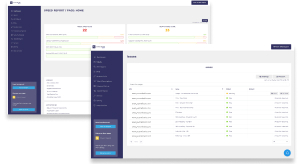
Plug In SEO was another app that made the list based on my research. Although there are cheaper tools available, like TinyIMG, I wanted to include it due to its keyword studio. With it, Plug In SEO can be a good companion to optimizing your content for search results.
Why I picked it:
While the app’s interface isn’t built for Shopify, I enjoyed its user-friendliness. Everything is clearly structured and easy to find. I really liked that the keyword studio gives you keyword suggestions together with their search volume and competitiveness.
Plug In SEO also offers a SEO scanner to audit your site, broken link fixing, and metadata editing. You can even easily edit schema markup settings without coding. What I found to be a drawback was that there’s no free plan, only a free 14-day trial for paid plans.
Who it’s for:
I’d recommend Plug In SEO for small to large site owners that are ready to invest in a paid plan. While on the pricier side, the app can help improve your pages for better search engine rankings with audits, metadata automation, and more.
Pros
- SEO scanner
- Metadata templates
- Keyword suggestions
Cons
- No free plan
- Expensive
How we test and review SEO apps for Shopify
I installed a few dozen SEO apps from the Shopify store and evaluated their setup process. Then, I spent a week reviewing what SEO features are automated and whether they work as intended. Before my tests, I also contacted each app’s support team to see how fast they respond.
Here’s exactly how me and my team test and review these best Shopify SEO apps:
- Hands-on testing. I installed and tested all SEO plugins on our test stores. We do this to get you real insights into how these apps work and their impact on your website performance and visibility in search engines.
- Expertise. Our team has vast experience in Shopify SEO app development, so we’ve tested the functionalities of various SEO plugins and have seen how they evolved throughout the years. We know what makes the best Shopify SEO app and can provide expert recommendations.
- Factors we considered. With the help of my team, I analyzed the SEO automation features these apps offer, their ease of use, pricing, free plan, and support. We also took into consideration the ratings and reviews, especially one-star reviews, and tried to replicate issues to check their consistency.
How do SEO apps help your Shopify store?
Shopify is SEO-friendly as an eCommerce platform, but naturally, you’ll still need additional SEO apps for mundane tasks. A good Shopify SEO app can help you with the following tasks:
- Automation. Many SEO-focused apps offer automation for tasks like metadata or product description generation, image compression, or even bulk edit modes. This can save you loads of time to focus on more important tasks, such as improving your backlink strategy or developing high-quality products.
- Keyword optimization. A Shopify SEO app can help optimize your content with keywords, whether it’s providing you with keyword suggestions or generating content that’s optimized for target keywords.
- Structured data. Some apps can even help implement structured data for those unfamiliar with coding. This helps search engines understand your website content better.
- Speed optimization. According to Google Search Central, website speed is a ranking factor for mobile search. That’s why the best SEO app will include features that will help you optimize your Shopify store’s page load time. This may include image optimization, lazy loading, or asset preloading.
- SEO audits. Having an app that gives you comprehensive SEO reports ensures you don’t miss any important issues on any of your pages. They can help you fix too many HTTP requests, show you what images are unoptimized or are missing metadata, and more.
- Conversion rate optimization. When improving your site for SEO, you’re not just gaining new visitors from higher search engine positions. You’re also enhancing user experience and reducing bounce rates. All of this can lead to higher click-through rates and, potentially, more sales.
External SEO tools for analytics
Some SEO tools are specifically made for analyzing certain aspects of your (or competitors’) website. Here are a few SEO tools you should consider for analytics:
- TinyIMG SEO extension – free extension available on Chrome made for providing users with comprehensive SEO insights of any site, including metadata, heading tags, page status, link insights, image details, schema markup overview, and more.
- Google Search Console – a free tool that allows you to analyze your website’s performance, get metric reports, diagnose SEO issues, and inspect URLs, pages, and their indexing problems.
- Google Analytics – free analytics tool essential for SEO metrics. It helps you monitor and analyze real-time insights into your website’s performance and search engine rankings.
- Google Keyword Planner – powerful research tool for improving your keyword strategy. It’s completely free, you just have to set up a Google Ads account.
- Ahrefs – comprehensive SEO tool for keyword research, site audit, rank tracking, competitive analysis, and more. You can get it starting from $108/month.
- Screaming Frog SEO Spider – a premium tool for analyzing SEO issues, such as locating broken links, missing metadata, or duplicate content. You can audit 500 URLs free of charge, but the paid plan costs $259/year.
Is having a Shopify SEO app enough?
A great Shopify SEO app is necessary, but it’s not everything. To follow the best SEO practices, you must have a comprehensive strategy in place.
We have compiled some resources for you. Read over them and combine them with the functionalities of your chosen SEO app for Shopify to take your store to the next level:
- Step-by-step Shopify SEO Guide for 2025
- Social Media SEO Guide in 2025
- How to Get Sales on Shopify Without Ads
- Complete Guide to Preloading Images on Shopify
Should you use an SEO plugin for Shopify?
Using a Shopify SEO plugin can help increase your site speed, optimize the user experience, and eventually improve your store rankings. It can be useful for creating keyword-optimized content, compressing your images, adding JSON-LD without coding, improving your backlink strategy, and more.
Our top recommendation is TinyIMG. It offers a great value-to-price ratio and comes with many SEO automation features. From image compression and broken link reports to JSON-LD, metadata generation, and more.
However, our list contains many great SEO tools, and the right pick depends on your store’s needs. So, consider what tasks you want to automate, what features you may find useful, and test the free versions to find the ultimate best option for you.
Frequently asked questions
Shopify has built-in SEO features to optimize your website. Automatic SEO features include auto-generated sitemap.xml and robots.txt files, title tags, and canonical tags to prevent duplicate pages. You can also optimize content by editing image alt text, meta descriptions, title tags, and URLs.
The best free SEO app for Shopify is TinyIMG because it offers 50 monthly optimizations, alt and filename optimization, instant speed-up, 30-day backups, and even 24/7 support. Other good free Shopify options for SEO are Booster SEO and Smart SEO.
Yes, if you use product tags strategically, they can help search engines like Google better understand your site navigation and product categories. Yet, keep in mind that not using product tags properly could lead to duplicate content.
Although Shopify doesn’t offer direct SEO ranking reports, you can check your ranking for free on Google Search Console (GSC). Just set up GSC for your store and go to Search results > Performance. You’ll find different queries your website ranks for and you can click them to see the average position in Google search results.


